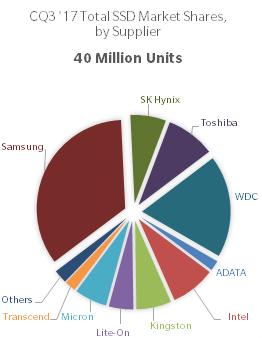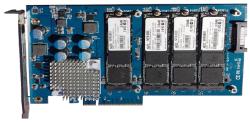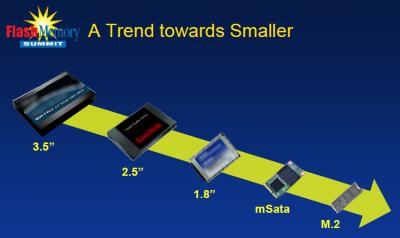 |
M.2 SSDs - news and
perspectivesincludes a list of nearly 40 companies which
make SSDs in the M.2 form factor (column on the righ) |
|
Contact us:
editor@storagesearch.com |
Dell EMC adopts M.2 SSD
array concept
Editor:- May 17, 2018 - The idea of using
M.2 SSDs as the raw flash
elements mounted on enterprise
PCIe SSD carriers and trays has gaining ground since it was proposed as an
evolutionary step by Liqid
in January 2016.
The M.2 array concept has the performance benefit of proportionality
(from NVMe PCIe scalability) coupled with the strategic business merit that M.2
is a competitively priced,
high volume form
factor which ensures that such modules will be at the forefront of new
technology adoption while also including within its ranks good value for money.
A
recent story -
Dell
EMC Takes a Stab at 1PB/1U With High Density M.2 Sleds (on
StorageReview.com) - shows a picture of a Dell EMC module with upto 10 M.2
SSDs in a single sled. ...read
the article
M.2 SSDs provide flash juice in Nallatech's new in-situ SSDs
Editor:-
March 19, 2018 - A new entrant to the in-situ SSD processing market is Nallatech which has
launched
its
250
series of NVMe storage accelerator modules which include application
programmable FPGAs closely coupled with memory. Among the models announced
today:-
- 250S+
- HHHL PCIe SSD accelerator featuring up to 4x M.2 NMVe SSDs and 4GB
SDRAM coupled on-card to a fully programmable Xilinx FPGA.
Nallatech
provides consultancy services assisting customers in the porting, optimization
and benchmarking of applications executed on Nallatech FPGA accelerators.
Innodisk joins industrial M.2 PCIe NVMe SSD market
Editor:-
February 21, 2018 - Innodisk
has joined the nascent market for industrial grade
M.2 PCIe NVMe SSDs and will
introduce
such new products (which will be available in both 2 and 4 lane PCIe 3.0
versions) at the Embedded World
event next week in Germany.
say
farewell to reassuringly boring industrial SSDs
M.2 PCIe SSDs were 50% of client shipments in Q3
Editor:-
November 15, 2017 - TrendFocus
today published
SSD
market shipment data for Q3 2017.
Only one segment, enterprise
PCIe, saw unit growth where every other segment – client drive format
factor, client modules, enterprise SATA and enterprise SAS, all declined from
the prior quarter.
 The
enterprise SSDs market declined 7% Q-Q, which includes
SATA,
SAS and
PCIe. The bright spot
within this overall decline was the healthy 15.6% increase in PCIe units. As
hyperscale companies continue to migrate away from SATA, PCIe should continue to
grow in both units and exabytes. SATA, still the highest volume of all
enterprise categories, managed to stay just above 4 million units shipped but
did decline sharply in CQ3. However, exabytes shipped in the SATA SSD market
grew due to the transition to higher capacity units. SAS SSDs now represent the
lowest unit volume of the enterprise SSD segments, but still maintain a large
lead in average capacity shipped at over 2.1 terabytes. The
enterprise SSDs market declined 7% Q-Q, which includes
SATA,
SAS and
PCIe. The bright spot
within this overall decline was the healthy 15.6% increase in PCIe units. As
hyperscale companies continue to migrate away from SATA, PCIe should continue to
grow in both units and exabytes. SATA, still the highest volume of all
enterprise categories, managed to stay just above 4 million units shipped but
did decline sharply in CQ3. However, exabytes shipped in the SATA SSD market
grew due to the transition to higher capacity units. SAS SSDs now represent the
lowest unit volume of the enterprise SSD segments, but still maintain a large
lead in average capacity shipped at over 2.1 terabytes.
Client SSD
shipments fell 4.5% sequentially but exabytes shipped was flat. Client modules
now represent almost 2/3 of all client SSDs shipped. Even more impressive within
this segment is that M.2
PCIe is now 50% of this segment – illustrating the continued migration for
major Notebook
OEMs to integrate with this interface.
BiTMICRO launches raft of NVMe SSDs for industrial and military
applications
Editor:- October 23, 2017 - BiTMICRO recently
announced several new SSDs for the
industrial and
military markets.
For
high capacity PCIe SSD
applications - a pragmatic approach for systems designers in recent years in
cloud markets has been to use carriers which can support multiple
M.2 SSDs. BiTMICRO
announced
the MAXio S-Series NVMe HHHL PCIe industrial grade PCIe x8 add-in card that
aggregates the performance and capacity of upto 4x M.2 SSDs in a temperature
tolerant, rugged reliable NVMe SSD with upto 8TB capacity today.
For
military 2.5" SATA and U.2 NVMe applications - BiTMICRO
announced
availability of 2 new secure erase SSDs which support a wide range of
temperatures, altitudes of up to 120,000 feet, and 1500G of shock. The new SSDs
are available with MLC or pSLC flash, maximum pSLC is 1TB, and maximum MLC is
2TB.
"BiTMICRO is an industry pioneer, delivering ruggedized and
secure solid state drives to leading customers in the industrial and military
markets for over 17 years, and has continually strived to meet the expectations
of our customers. This level of customer support coupled with our experienced
team and proprietary technology differentiates our product offerings from the
rest of the market," said Stephen Uriarte,
President of BiTMICRO.
Swissbit to show low power industrial M.2 NVMe PCIe SSD at FMS
Editor:-
July 20, 2017 - Swissbit
today said it will show a prototype of a new low power industrial M.2 NVMe PCIe
SSD at the Flash Memory Summit
next month.
Swissbit says - "Whilst the popular 4-lane/8-channel
NVMe products are tuned for the highest data rate, Swissbit's N-10 has a
different focus: With its 2-lane/4-channel architecture, N-10 can offer more
than double the performance of an SSD with SATA 6Gb/s interface, and
significantly reduces power consumption."
Transcend's new M.2 SSD
Editor:- March 27, 2017 -
Transcend
today launched the MTE850
- a family of PCIe Gen 3 x 4 M.2
SSDs with 512GB of 3D MLC NAND capacity and R/W speeds upto 2.5GB/s and
1.1GB/s, respectively aimed at the
consumer market.
M.2 PCIe SSDs for secure industrial / military applications?
Editor:-
March 20, 2017 - Do you know who makes
M.2 PCIe SSDs which can
operate at
industrial
temperatures and have security
strong enough for a military application?
That's a question I was
asked recently by a reader in the
defense sector.
So
I looked into it. He was right. They are hard to find. (Nearly all the
industrial M.2 SSDs are
SATA and not
PCIe.) And the
manufacturers' own websites hinder the discovery process.
The only
companies which I have been able to confirm in this category (by direct
contact rather than a promissory future web note) are:-
I
became interested in the technical difficulties which might explain why
there are so few suppliers right now. Here's what I think is part of the
explanation.
As you add operational requirements to the datasheet
moving up from consumer to enterprise and then to industrial SSDs you also add
circuits and components which compete for physical space, electrical power and
cost in the total SSD
design budget.
- use of larger
flash
memory cell geometry (nanometer generation and coding type - for example
SLC rather than MLC, or MLC rather than TLC) to ensure data integrity over a
wider range of temperature and power supply quality environments
- use of different flash
SSD controllers
Consumer and enterprise SSDs can use controllers
which use more electrical power than industrial or embedded SSDs due to the ease
of fitting the design into the heat rise budget.
Industrial designs
can't afford the same wattage in their controllers - because the heat generated
would reduce the reliability
of the SSD at the high end of its operating temperature range (70 to 85
degress C and sometimes 95 degrees) - or force the use of more expensive
components elsewhere (to cope with the incremental heat rise. The tradeoffs made
(typically lower wattage controller) is why industrial SSDs tend not to use
CPU intensive data integrity management schemes like
adaptive DSP.
And that in turn means they need to use intrinsically higher quality memory.
When you add all the requirements together to make an industrial /
military SSD capable of working reliably and shrink the size budget from a
bigger to smaller form factor (2.5" to M.2) while at the same time asking
for high performance too - it's a tough design problem to solve for the first
time.
But once such products do became available from multiple sources
then demand will grow (due to confidence in the equipment design community
that they won't get stuck in an
EOL rut from a single
source dependency).
If you know of other secure erase, industrial
operation M.2 PCIe SSD companies which are shipping products let me know and
I'll mention them here.
Recadata enters rugged M.2 SSD market
Editor:-
December 20, 2016 - The M.2 SSD
form factor was originally designed as a mainstream solution for
consumer SSDs but
in recent years we've seen many new M.2 products appearing in other markets
where size matters too.
Today Recadata - which is
best known for its rugged SSDs aimed at
military systems
launched
an M.2 SSD product line - the
M700 Series M.2 SSD
series.
Corsair enters M.2 NVMe PCIe SSD market
Editor:-
December 13, 2016 - Corsair
today
announced
its entry into the M.2 SSD
market with a new PCIe Gen. 3 x4 product aimed at the
consumer upgrade
market. The
Force
MP500 is Corsair's fastest SSD and uses a
controller from
Phison.
in-situ SSD company enters Top 5 SSD Companies List in Q3 2016
Editor:-
November 24, 2016 -
NxGn (a pioneer in
in-situ processing inside SSDs) achieved its highest ever ranking in the new
Q3 2016 edition of
the Top SSD Companies
published today.
Seagate unveils 2TB enterprise M.2
Editor:- July 26,
2016 - Seagate
today
unveiled
a 2TB M.2 NVMe PCIe SSD
aimed at the enterprise market. The Nytro XM1440 M.2 - which will ship in
November 2016 - will offer 30K IOPS / Watt.
Virtium offers encryption in all its industrial SSD form factors
Editor:-
June 28, 2016 - Virtium
today announced self-encrypting drive features as options throughout all the
form factors in its StorFly range of industrial SSDs.
"These
support multiple SATA form factors, including 2.5", 1.8", Slim SATA,
mSATA, M.2, and CFast" said Scott Phillips,
VP of marketing at Virtium.
Virtium says many industrial-system makers
and their customers continue to push functionality closer and closer to the
network edge and the end-customer. This puts systems and the data they hold at
risk of hacking and data theft. Virtium's new SEDs provide
security for data at
rest without sacrificing industrial features.
Toshiba launches fast M.2 SSD for notebooks
Editor:-
May 19, 2016 -
May 24, 2016 - Toshiba today launched
its fastest yet SSD for the
consumer upgrade
market in the US. The OCZ RD400
is an M.2 form factor NVMe
PCIe SSD with 0.3 DWPD
endurance and sequential R/W of 2,200 / 620MB/s (for the entry level 128GB
model).
AMD enters M.2 SSD market
Editor:- May 16, 2016 -
AMD is now
offering a range of branded M.2 SSDs for the
consumer market. A
blog on CIO.com discusses the details
here.
using M.2 in server slots - article by Liqid
Editor:-
January 30, 2016 - An
article
on the evolution of SSD form factors with reference to M.2 (pdf) - by Liqid - discusses how
M.2 SSDs can be used in
enterprise PCIe SSD
environments which don't have native M.2 PCIe slots - by using add in carrier
cards.

The
image above (from Liqid's article) shows the evolution of SSD and HDD form
factors in progressively smaller form factors from 1989 (5¼") to M.2
in 2014.
Although to be fair to the
hard drive market the
image doesn't show the smallest hard drives - such as the 0.85" hard
drive from Toshiba (in
January 2004) and
1" hard drive from Cornice
(in August 2006).
The 1" HDD market didn't last long.
It was the first
hard drive extinction event caused by adoption of flash SSDs. ...read
the article (pdf)
new TB PCIe SSD on M.2 from OCZ
Editor:- January 5,
2016 - OCZ says it
will show new NVMe PCIe SSDs with 1TB capacity and up to 2.4GB/s of bandwidth on
a single
M.2 module at
CES this week.
dual port GbE with USB in the same M.2 SSD from InnoDisk
Editor:-
November 3, 2015 - InnoDisk
today
announced
a product first for the M.2 SSD
market in the shape of a dual port isolated GbE compatible model -
EGUL-G201 - which also has a USB
3 interface, and fits in a 22x60mm footprint. InnoDisk says the ethernet modules
have strong electrical isolation, ESD and surge protection.
 1x
M.2 NVMe SSD good 1x
M.2 NVMe SSD good
4 is better says Memoright
Editor:-
September 3, 2015 - Memoright
discussed the possibilities arising from using an array of 4x
M.2
NVMe PCIe SSDs packed onto a single PCIe switch card as a way of building
competitively priced SSD accelerated servers - in a paper
Using
a PCIe-Based Switch Module to Enhance Enterprise Storage Architecture (pdf)
presented at the recent Flash
Memory Summit. Each of the new M.2 SSDs from Memoright would have upto 1TB
capacity and R/W IOPS upto 81K / 54K respectively.
world's first M.2 MRAM SSD
Editor:- August 13, 2015 -
Everspin Technologies
and Aupera Technologies
today
announced the launch of
the world's first all MRAM storage module in the
M.2 form factor.
The AupM001 is
equipped with Everspin's non-volatile, high endurance, 64 Mb DDR3 ST-MRAM
devices and a PCIe backhaul interface. AupM001's capacity is 32MB and among
other uses is used in Aupera's all Flash Array system for applications that
require low latency and high performance.
Seagate promises M.2 NVMe SSDs early next year
Editor:-
August 11, 2015 - Seagate
today
announced
details of 2 new families of
NVMe SSDs which
will be available in 2.5"
(October) and M.2 (in early
2016) form factors.
Seagate will demonstrate these new SSDs this week
at the Flash Memory Summit.
Lite-On says small NVMe M.2 PCIe SSDs could be a good fit for
datacenter
Editor:- August 6, 2015 - Lite-On today
unveiled
a new NVMe M.2 PCIe SSD for datacenter environments.
The EP2 series
delivers R/W IOPS up to 250K /25K respectively and low latencies of 35/35 (µs).
It also has power loss protection, scalability, end-to-end data protection,
low power consumption, high endurance, sustained performance, and customized
firmware.
Editor's comments:- in an earlier
press
release (in June
2015) about supplying a related product line to an unnamed customer
described as "one of the largest cloud service providers" Jeffrey Chang,
Lite-On's Technical Product Manager said "The
M.2 is perfect for where we
believe the future of enterprise
SSD cloud storage is going."
Virtium launches industrial M.2 PCIe SSDs
Editor:-
July 28, 2015 - Virtium
today
announced
it has expanded its StorFly range of industrial SSDs with new
PCIe SSDs (gen 2)
available in both M.2 and
Mini Card form factors with capacities from 16GB upto 480GB and low power
requirements <4W.
Endurance is upto 3.3 petabytes of writes (about
3.7
DWPD for 5 years).
Virtium's new SSDs have full BOM control with up to 5 years of uninterrupted
product availability.
Phison's SSDs at Computex
Editor:- June 5, 2015 - New
SSDs from Phison
including models for these markets:-
M.2,
2.5" NVMe SSDs
and conventional (HHHL) PCIe
SSDs are discussed in a new blog -
Phison
Computex Update on the SSD Review.
cooling fans essential for high speed operation of Samsung's new
M.2 PCIe SSDs
Editor:- April 13, 2015 -
Samsung's M.2
PCIe SSD - the SM951 - launched in January 2015 (scroll down to see the
original news story) is the subject a recent
evaluation
in the SSD Review. Among other things it was interesting to see how
much the
temperature
of the SSD heated up when operating at high speed and heavy workloads and
the importance of accurately designed heat extraction if you plan to use this
SSD in such a way.
See also:-
other
reviews of this product, M.2
SSDs,
temperature
considerations in SSDs (pdf),
industrial SSDs
Sonnet's "Fusion PCIe Flash Drive" has M.2 inside
Editor:-
April 7, 2015 - Sonnet
Technologies has today
launched
a new consumer storage module called the "Fusion PCIe Flash Drive"
which has an M.2 SSD inside.

"The
Fusion PCIe Flash Drive leverages the latest advancements in PCIe SSD design and
Thunderbolt 2 technology, enabling Sonnet to offer a storage device that fits
neatly in the palm of your hand yet delivers the blazing-fast performance of a
multi-drive RAID storage system many times its size," said Robert Farnsworth,
Sonnet Technologies CEO. "We think this will become an indispensable
accessory for the creative professional."
|
|
| Samsung
mass producing gen 3 PCIe SSDs for notebooks |
Editor:- January 7, 2015 - 19
months after launching its first M.2 PCIe gen 2 SSDs aimed at the
notebook
market (the
XP941
(pdf) in June
2013) - Samsung
said it is now mass producing the follow-up SM951 - which supports gen 3
PCIe.
Samsung says - "For ultra-slim notebooks and workstations
the SM951 can read and write sequentially at 2,150MB/s and 1,550 MB/s
respectively..."
The SM951 is the first SSD to adopt L1.2 low
power standby mode (the PCIe
SSD equivalent of the power saving
devsleep
mode in SATA SSDs) .
When hibernating in
L1.2
mode, the SM951's power consumption is less than 2mW.
SMART Modular enters the M.2 SSD market
Editor:- November
11, 2014 - SMART Modular
today
announced
it is sampling a new M.2 SATA SSD for enterprise applications with 32GB to
512GB capacity (19nm MLC) and R/W speeds upto 540Mbytes/sec and 320Mbytes/sec,
respectively.
See also:-
M.2
SSDs - mentions on StorageSearch.com,
industrial SSDs
Micron's new M.2 SSDs
Editor:- September 16, 2014 -
Micron today
launched
the M600
SATA SSD family - a low power (150mW typ), range using 16nm flash - and
available in M.2, mSATA and 2.5" form factors.
Super Talent joins M.2 PCIe SSD market
Editor:-
August 11, 2014 - Super Talent
Technology today
announced
that it has added an
M.2 form factor SSD to its
NGFF
family of SSDs.
Super Talent's
PCIe
DX1 has a PCIe gen 2 interface, R/W speeds upto 480/400MB/s respectively,
capacity upto 256GB MLC and comes with a 128MB DDR3 DRAM cache.
Plextor's M.2 PCIe SSD wins award at FMS
Editor:-
August 7, 2014 - Plextor
today announced
that its
M6e
- an M.2 PCIe SSD - has
won Best of Show for most Innovative flash memory technology at the Flash Memory Summit.
The
M6e SSD combines a multi-core
Marvell PCIe 9183
controller and Toshiba
toggle NAND flash with firmware developed by Plextor's in-house team.
As
part of the design verification - Plextor says that 400 units were subjected to
500 hours of extreme tests without error or failure.
NxGn Data exits stealth with promise of in-situ SSD processing
Editor:-
July 29, 2014 -
NxGn Data today
exited stealth mode.
NxGn will use
advanced
adaptive DSP technology to enable small form factor SSDs (such as
M.2)
aimed at the enterprise market - using MLC and TLC down to 1z-nm geometries.
Fully functional FPGA-based samples will be available in early 2015,
followed by final production samples of SoC-based M.2 solutions in late 2015.
NxGn
says it will be the first SSD controller company in the industry with
in-storage computation capability - what it calls "In-Situ Processing".
Editor's
comments:- Earlier this year I published a couple of reports and mentions
about SSD suppliers (LSI
and Memblaze) who
have modifed their controller firmware to eliminate or bypass functions from the
lowest level SSD drive - for large customers like Baidu - who then use their
array level software to get better utilization and performance.
And in
the industrial
market InnoDisk - uses
what it calls 3rd generation architecture - to partition intelligent data
actions between the controller and software stack.
Until recently -
only Fusion-io (in
whose products the flash controller and apps server - share the same CPU cores)
has been able to maximize high end context intelligence with low level flash
block data access at a similar latency level.
But once you've solved
the problem of making SSDs reliable and fast - it's tempting to create an SSD
instruction set which which focuses on application layer needs too - and not
just those of dumb storage.
See also:-
Active
Flash: Towards Energy-Efficient, In-Situ Data Analytics on Extreme-Scale
Machines
M.2 duplicators from Addonics
Editor:- June 5, 2014
- It's been many years since I talked about
disk duplicators so
it was interesting to see this
announcement
today from Addonics
- which puts a new spin on their reformfactoring technologies.
The gist
is - that if you need to duplicate M.2 SSDs - they can supply a duplicator -
and carrier kits which convert the M.2 to 2.5". They also have adapters for
CF, CFast etc. more
details here.
Unigen Announces M.2 SSDs
Editor:- June 3, 2014 - Unigen today
announced SLC or MLC
NAND flash based
M.2 SATA III SSDs in
densities ranging from 16GB- 256GB. These small form factor flash modules are
used for high reliability storage of critical code and data, in
space-constrained embedded, industrial, gaming and networking applications.
They are available in both commercial and
industrial
temperature ranges.
Micron samples Marvell based M.2
Editor:- March 18,
2014 - Micron
today
announced
it's sampling a 512GB M.2 SATA
SATA SSD - the
M550
(with DEVSLP and 550/500MB/s R/W speeds) - aimed at
consumer markets -
which is based on Marvell's
88SS9189 controller.
LSI integrates "SSD market on a chip"
Editor:-
November 18, 2013 - LSI
today
launched
its 3rd generation SandForce SSD controller family - the SF3700 which - based
around a single chip design - spans a wide spectrum of SSD market
applications (from consumer to enterprise) - includes native jumper-selectable
SATA or gen 2 PCIe interfaces - and incorporates adaptive R/W DSP ECC
management.
Editor's comments:- The SF3700 (now sampling) is
the most ambitious design of a single chip
SSD controller in
SSD market
history.
Its 14 core design integrates many impressive design and
architectural features including:-
- the ability to efficiently configure as either
a small
architecture or big architecture SSD controller.
The SF3700
design can be configured with as little as 3 flash chips in entry level
consumer SSDs - or as many as 129 chips when maximally configured in a 9 channel
enterprise design which can recover from the complete failure of a memory chip
as well as partial failures in other memory chips in the array.
- dynamically adjusted power islands within the chip - enable a single
silicon design to support both the low requirements of deep sleep mode in SATA
notebooks as well as the performance requirements of entry level PCIe SSDs.
I
recently spoke to Kent
Smith at LSI about this new product.
Our conversations about
SandForce SSD controllers go back more than 4 years - so we skipped a lot of
stuff.
One of the first things I said to Kent - was - I've been
nagging you for years and asking - when are you going to do a native PCIe SSD
controller?- and for nearly 2 years it's been clear that another big hole in
LSI's SSD IP bag has been
adaptive R/W
- and now you've finally done both at the same time in a single product.
I
was also really impressed by the quality of LSI's
briefing
document on the LSI SandForce SF3700 (pdf) - which explains just about
everything you need to know. So I asked Kent - why does he need to waste time
talking to editor's like me? - why doesn't LSI just publish the document on the
web and let it speak for itself?
I said a lot of publications will
simply copy some of your pictures without attribution - and I think readers
would find it valuable seeing them too - but I think it would be fairer to the
work you've done if I could just make the whole document available - so there
was no doubt who had done the hard work of communicating what the design was all
about.
He agreed to that - and you can click on the link above to see
the original info which I got from LSI.
Some other things I learned
from this conversations were:-
- The SF3700 is a completely new design. - It leverages all the flash
related design concepts related to endurance and array level fault management
which have been proven in earlier designs and extends them too.
For
example RAISE has been enhanced so that for high-end configurations it can
protect against a full memory chip failure as well as multiple block faults -
whereas entry level SSDs which need some RAID like features but can't afford an
extra memory chip can use fractional RAISE.
- One of the reference designs which LSI offers for this controller is for an
M.2 form factor - which is
goiing to be the game changing SSD for the
consumer market
next year. The card design is the same whether the SSD is being used as a
SATA or PCIe SSD. A single jumper sets the configuration at assembly time.
LSI's 2.5" reference design will also make it easier for oems to
produce products for enterprise arrays in the
2.5" PCIe SSD market. Overall
I think the SF3700 is a very ambitious and outstanding SSD controller design -
which will elevate LSI's reputation within the SSD industry.
Samsung enters PCIe SSD market
Editor:- June 17,
2013 - Samsung
has entered the PCIe SSD
market with an M.2 form
factor model (80mm x 22mm) aimed at
notebooks.
Samsung's XP941 - which weighs less than 6g - has a sequential read
performance of 1,400MB/s, and capacity up to 512GB.
Editor's
comments:- the
SSD notebook
market began the year before PCIe SSDs started being used in the
enterprise.
But in the first 5 years of its history (2006-2010) the
notebook SSD market was a disappointment to SSD evangelists like me - because
integration with PCs was so bad. And for years on these pages I ranted that
notebooks using SSDs would never be able to reach their true potential as long
as they were still wasting their inherently light CPU resources and latency
advantages by talking to the CPU via old fashioned
hard disk interfaces
like SATA.
The
exciting thing about today's announcement by Samsung is that consumer grade
PCIe SSDs for notebooks will enable a dramatically different user experience
which will help to create new markets.
Will there be a crossover into
the enterprise market?
It's inevitable that some people will ask -
what would an array of consumer priced PCIe SSDs look like in a box? And no
doubt you will probably see such products coming onto the market. And that
might lead to a temporary state of user confusion about expectations for PCIe
SSDs.
But setting aside for the moment the obvious considerations at
the single drive level of differences in
endurance
and performance
characteristics - I think the key differentiators of enterprise PCIe SSDs
compared to consumer
PCIe SSDs are the different degree of
data integrity
(higher for the enterprise),
power fail
management and support for fault tolerance.
|
| |
| . |
|

|
| . |
| |
.... |
|














 1x
M.2 NVMe SSD good
1x
M.2 NVMe SSD good 


